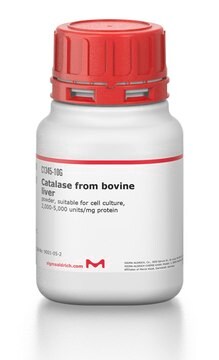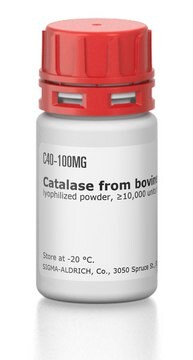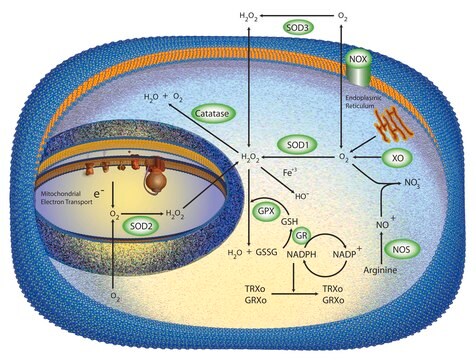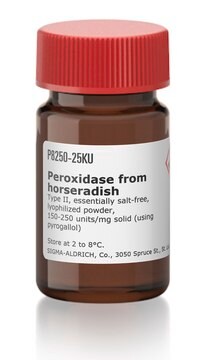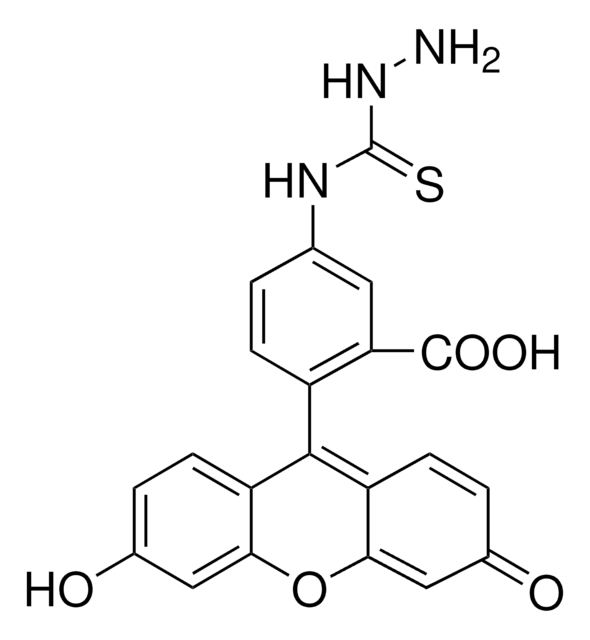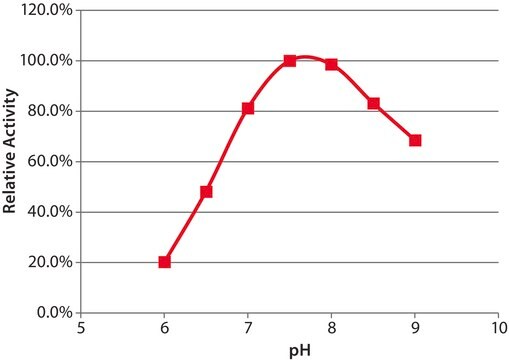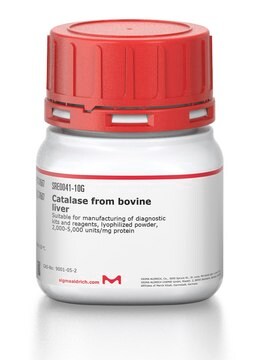G7400
Galactose Oxidase from Dactylium dendroides
lyophilized powder, ≥3,000 units/g solid
Sinónimos:
D-Galactose:oxygen 6-oxidoreductase
Iniciar sesiónpara Ver la Fijación de precios por contrato y de la organización
About This Item
Productos recomendados
biological source
fungus (Dactylium dendroides)
Quality Level
form
lyophilized powder
specific activity
≥3,000 units/g solid
storage temp.
−20°C
¿Está buscando productos similares? Visita Guía de comparación de productos
General description
Galactose oxidase is an extracellular copper-containing enzyme, secreted by the deuteromycete fungus Dactylium dendroides. It catalyzes the oxidation of a range of primary alcohols, including D-galactose, to the corresponding aldehyde, with reduction of oxygen to hydrogen peroxide.
Application
Galactose oxidase may be used as an analytical tool for the specific determination of D-galactose in blood plasma, plant extracts, and phospholipids. It could be used for the characterization of terminal D-galactoside units in several polymers.
Biochem/physiol Actions
Galactose oxidase catalyzes the coversion of D-galactose to D-galacto-hexodialdose.
2-Deoxy-D-galactose, lactose, melibiose, raffinose and stachyose react with galactose oxidase in the peroxidase:o-tolidine system.
Essentially no oxidation of D-glucose, L-galactose, L-arabinose or D-glucuronate has been observed.
2-Deoxy-D-galactose, lactose, melibiose, raffinose and stachyose react with galactose oxidase in the peroxidase:o-tolidine system.
Essentially no oxidation of D-glucose, L-galactose, L-arabinose or D-glucuronate has been observed.
Unit Definition
One unit will produce a ΔA425 of 1.0 per min at pH 6.0 at 25 °C, in a peroxidase and o-tolidine system. Reaction volume = 3.4 mL. Light path = 1 cm.
inhibitor
Referencia del producto
Descripción
Precios
related product
Referencia del producto
Descripción
Precios
signalword
Danger
hcodes
pcodes
Hazard Classifications
Resp. Sens. 1
Storage Class
11 - Combustible Solids
wgk_germany
WGK 1
flash_point_f
Not applicable
flash_point_c
Not applicable
Elija entre una de las versiones más recientes:
¿Ya tiene este producto?
Encuentre la documentación para los productos que ha comprado recientemente en la Biblioteca de documentos.
Los clientes también vieron
Bei Yue et al.
Frontiers in pharmacology, 12, 774560-774560 (2021-11-20)
Irinotecan (CPT11), a broad-spectrum cytotoxic anticancer agent, induces a series of toxic side-effects. The most conspicuous side-effect is gastrointestinal mucositis, including nausea, vomiting, and diarrhea. A growing body of evidence indicates that bacteria β-glucuronidase (GUS), an enzyme expressed by intestinal
M J McPherson et al.
The Journal of biological chemistry, 267(12), 8146-8152 (1992-04-25)
The gaoA gene, encoding the secreted copper-containing enzyme galactose oxidase, has been isolated from the Deuteromycete fungus Dactylium dendroides. Degenerate oligonucleotide primers were designed from amino acid sequence data for use in the polymerase chain reaction. A 1.4-kilobase DNA fragment
Takeshi Ito et al.
Talanta, 85(1), 707-712 (2011-06-08)
We proposed a low cost fabrication procedure of a poly(methylmethacrylate) (PMMA) column chip. 3D microchannel structure consisting of four columns in a chip for a mother die was fabricated using dry film photoresist and photolithography technique. Electroforming was applied to
Avgousta Ioannou et al.
Chemical communications (Cambridge, England), 47(40), 11228-11230 (2011-09-15)
Galactose oxidase (GOase) was shown to oxidise several C2/C3 fluorinated galactose analogues. Interestingly, the enzyme was able to distinguish between the 2,3-tetrafluorinated galactose and its epimeric glucose analogue, and this represents the first reported biotransformation of a heavily fluorinated sugar.
Fabio Aparecido Cordeiro et al.
Journal of basic microbiology, 50(6), 527-537 (2010-11-16)
Galactose oxidase (GO) converts galactose to an aldehyde and has several biotechnological applications, including cancer diagnosis. It is mainly produced by Fusarium austroamericanum but is also produced by Fusarium acuminatum and by isolates of the Fusarium graminearum and Gibberella fujikuroi
Nuestro equipo de científicos tiene experiencia en todas las áreas de investigación: Ciencias de la vida, Ciencia de los materiales, Síntesis química, Cromatografía, Analítica y muchas otras.
Póngase en contacto con el Servicio técnico


